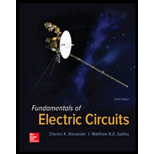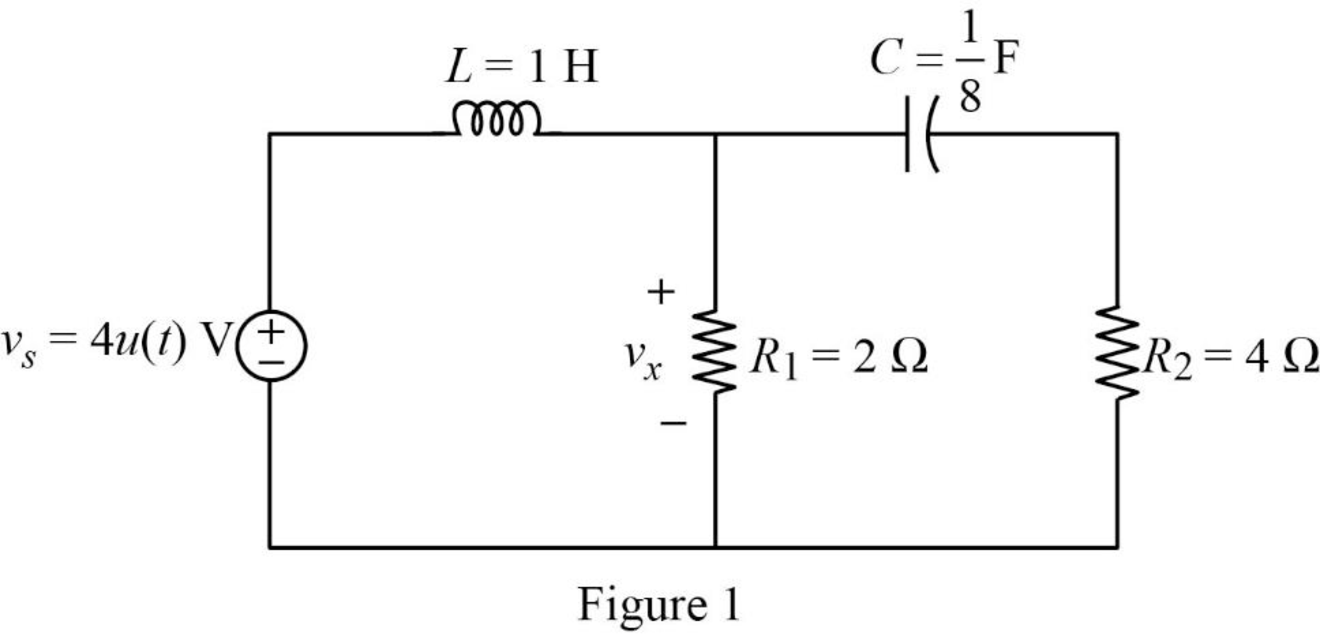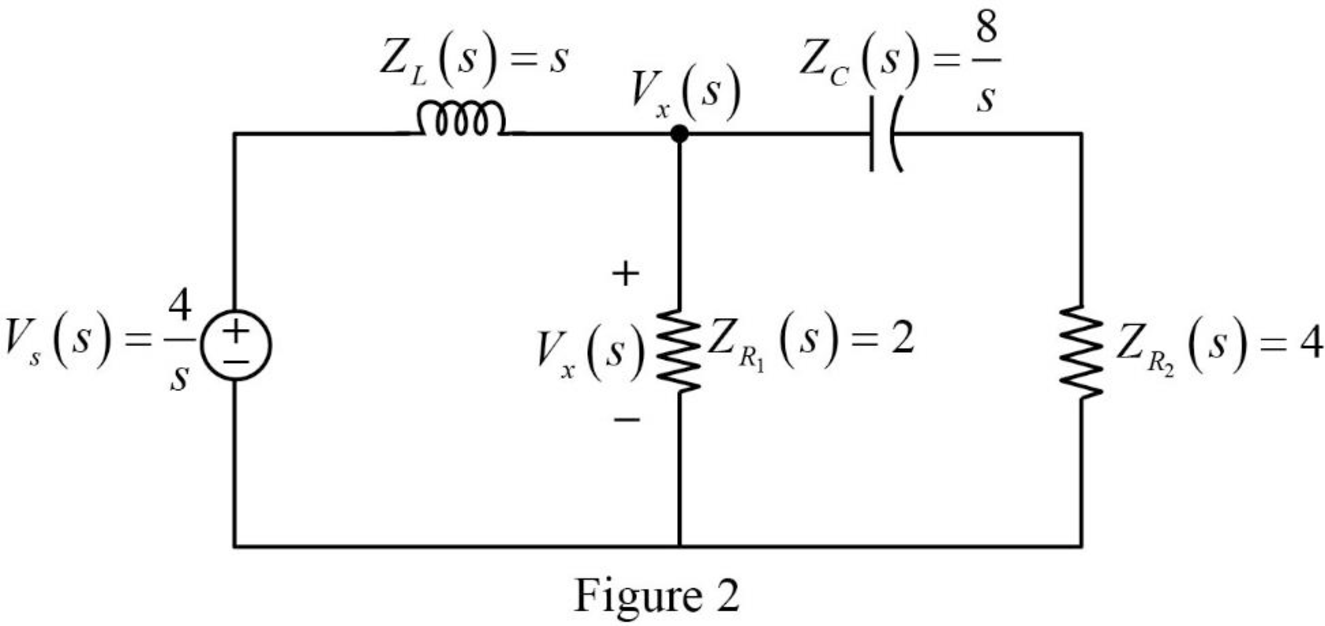
Concept explainers
Design a problem to better understand the circuit analysis using Laplace transform using Figure 16.36.
Explanation of Solution
Problem design:
Find the value of voltage across resistor
Formula used:
Write a general expression to calculate the impedance of a resistor in s-domain.
Here,
Write a general expression to calculate the impedance of an inductor in s-domain.
Here,
Write a general expression to calculate the impedance of a capacitor in s-domain.
Here,
Calculation:
The given circuit is redrawn as shown in Figure 1.

Apply Laplace transform to the voltage source
Substitute
Substitute
Substitute
Substitute
Convert the Figure 1 into s-domain.

Apply Kirchhoff’s current law at node
Simplify the above equation as follows,
Simplify the above equation to find
From equation (4), the characteristic equation is written as follows,
Write an expression to calculate the roots of characteristic equation
Here,
Compare equation (5) with quadratic equation
Substitute
Now, the equation (4) is written as follows,
Take partial fraction for equation (7).
The equation (8) can also be written as follows,
Simplify the above equation as follows,
Substitute
Simplify the above equation as follows,
Simplify the above equation to find
Substitute
Simplify the above equation as follows,
Simplify the above equation to find
Substitute
Simplify the above equation as follows,
Simplify the above equation to find
Substitute
Take inverse Laplace transform for equation (10) to find
Simplify the above equation to find
Conclusion:
Thus, the problem to better understand the circuit analysis using Laplace transform is designed.
Want to see more full solutions like this?
Chapter 16 Solutions
Fundamentals of Electric Circuits
- Find the transfer function, Vo(s)/Vi(s), please show all your solutions, convert the given circuit to laplace equivalent and state your variables.arrow_forwardSignal and system The mathematical model of a system is y" (t) + ay'(t) + by(t) = a (t) + ca (t) where a=1, b=2 and c=1. 1) Find zeros and poles of the system. 2) Show them onto the S-Plane (the complex plane) 3) Discuss the BIBO stability of the system.arrow_forwardObtain the transfer functions X1(s)/U(s) and X2 (s)/U(s) of the mechanical system.arrow_forward
- Suppose an LTI system has impulse response h(t)=u(t+1)−u(t−1),and input x(t)=t[u(t−1)−u(t−6)]. Use graphical convolution method to determine the zero-state response. Do not use Laplace transformarrow_forwardUsing the laplace transformation table, evaluate the following, consideringany other variable other than t as constant: L[rt sin^2(rt)]arrow_forwardObtain the transfer function of the given electrical system below expressed in Laplace form s . Let i(t) be the input of the system and the voltage across R4 be the output of the system.arrow_forward
- solve the difference equation using the z transform: 6yk+2-yk+1-yk=0 where, y(0)=0,y(1)=1arrow_forwardSolve the following differential equations by using Laplace transform method. a) y'' +2y' + y = 4e−t where y(0)= 2 y'(0)= 4 .arrow_forwardThe switch was open for a long time but closed at t=0 Determine: (a) i(0 ), v(0 ), (b) di(0 ) dt, dv(0 ) dt, (c) i(infinity ), v(infinity).Apply Laplace transform to the given RLC circuit to solve differential equations with initial conditions. Please in typing formatarrow_forward
- Find the poles and zeros of the following functions. Mark the finite poles with × and the finite zeros with 0 in the s-plane. G(s) = 10(s+2)/s*(s^2+2s+2)arrow_forwardThank you kindly. The follow-up question is "Find v(t) for t>0 in the circuit, using the Laplace equivalent circuit. Assume i(0) = 2A.arrow_forwardanalytical part, whose imaginary part is given belowWhich of the following is the real part of the complex function f(z)=u(x,y)+iv(x,y)?arrow_forward
 Introductory Circuit Analysis (13th Edition)Electrical EngineeringISBN:9780133923605Author:Robert L. BoylestadPublisher:PEARSON
Introductory Circuit Analysis (13th Edition)Electrical EngineeringISBN:9780133923605Author:Robert L. BoylestadPublisher:PEARSON Delmar's Standard Textbook Of ElectricityElectrical EngineeringISBN:9781337900348Author:Stephen L. HermanPublisher:Cengage Learning
Delmar's Standard Textbook Of ElectricityElectrical EngineeringISBN:9781337900348Author:Stephen L. HermanPublisher:Cengage Learning Programmable Logic ControllersElectrical EngineeringISBN:9780073373843Author:Frank D. PetruzellaPublisher:McGraw-Hill Education
Programmable Logic ControllersElectrical EngineeringISBN:9780073373843Author:Frank D. PetruzellaPublisher:McGraw-Hill Education Fundamentals of Electric CircuitsElectrical EngineeringISBN:9780078028229Author:Charles K Alexander, Matthew SadikuPublisher:McGraw-Hill Education
Fundamentals of Electric CircuitsElectrical EngineeringISBN:9780078028229Author:Charles K Alexander, Matthew SadikuPublisher:McGraw-Hill Education Electric Circuits. (11th Edition)Electrical EngineeringISBN:9780134746968Author:James W. Nilsson, Susan RiedelPublisher:PEARSON
Electric Circuits. (11th Edition)Electrical EngineeringISBN:9780134746968Author:James W. Nilsson, Susan RiedelPublisher:PEARSON Engineering ElectromagneticsElectrical EngineeringISBN:9780078028151Author:Hayt, William H. (william Hart), Jr, BUCK, John A.Publisher:Mcgraw-hill Education,
Engineering ElectromagneticsElectrical EngineeringISBN:9780078028151Author:Hayt, William H. (william Hart), Jr, BUCK, John A.Publisher:Mcgraw-hill Education,





